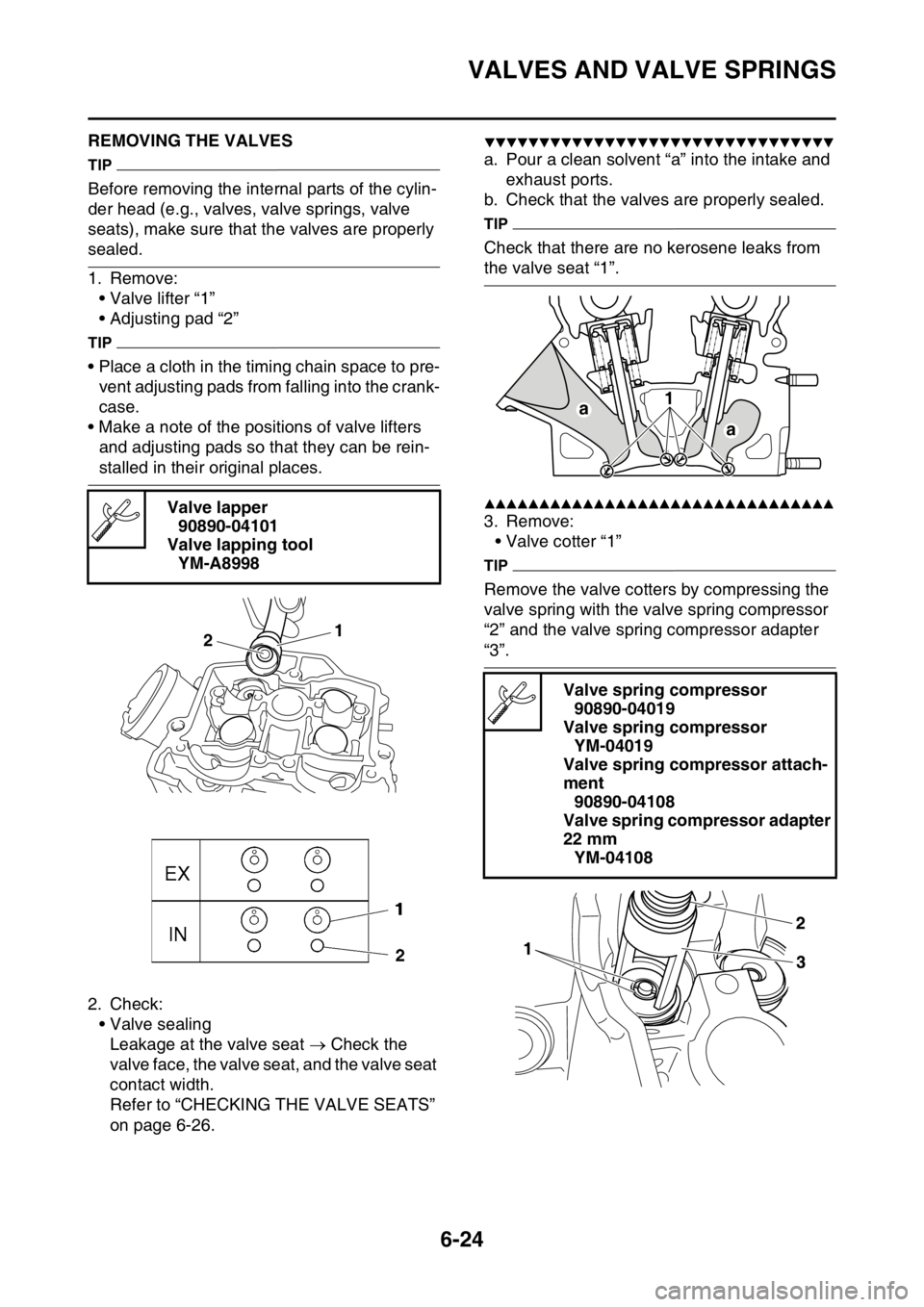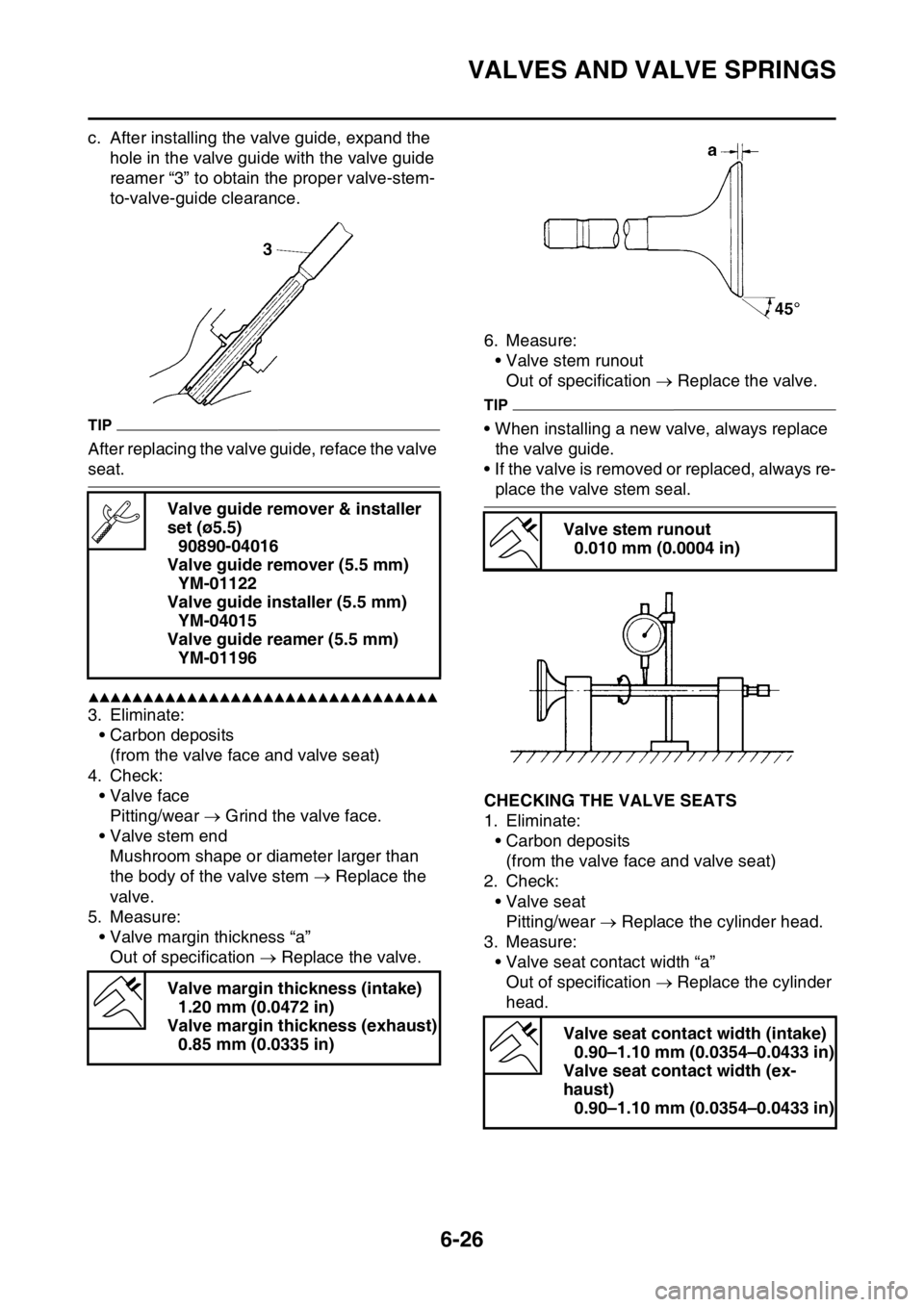seats YAMAHA WR 450F 2016 Owners Manual
[x] Cancel search | Manufacturer: YAMAHA, Model Year: 2016, Model line: WR 450F, Model: YAMAHA WR 450F 2016Pages: 426, PDF Size: 10.86 MB
Page 72 of 426

LUBRICATION POINTS AND LUBRICANT TYPES
2-21
EAS2GC1068
LUBRICATION POINTS AND LUBRICANT TYPES
EAS2GC1069ENGINE
Lubrication point Lubricant types
Oil seal lips
Bearing
O-ring
Camshaft cap bolt threads and contacting surface
Cylinder head bolt threads, seats, washers
Valve stems
Valve stem ends
Valve lifter outer surface
Camshaft lobe and journal
Valve lifter top surface
Crankshaft journal
Crankshaft big end thrust surfaces
Piston outer surface
Piston pin outer surface
Decompression system moving parts
Water pump impeller shaft
Oil pump rotors (inner and outer)
Oil passage gasket
Oil pump shaft
Kick gear and ratchet wheel
Kick shaft
Kick idle gear inner surface
Ratchet wheel and ratchet wheel guide contacting portion
Primary drive gear nut threads and contacting surface
Primary driven gear inner surface and end surface
Clutch push rod washer
Clutch push rod 1 outer surface
Clutch push rod 1 thrust surface
Clutch push rod 2 outer surface
Push lever shaft outer surface
Transmission gear inner surface (wheel and pinion) and collar
Transmission gears (shift fork groove)
Shift cam grooves
Shift fork and shift fork guide outer surface
Shift shaft and collar
Shift lever assembly moving parts
Damper assembly shaft, thrust surfaces, washers
LS
E
LS
E
M
M
M
E
M
E
M
E
E
M
E
E
E
LS
E
M
E
E
M
E
E
E
E
E
E
E
M
E
E
E
E
E
E
Page 102 of 426

PERIODIC MAINTENANCE
3-4
EAS2GC1078MAINTENANCE INTERVALS FOR COMPETITION USE
TIP
• The following schedule is intended as a general guide to maintenance and lubrication. Bear in mind that such factors as weather, terrain, geographical location, and individual usage will alter the re-
quired maintenance and lubrication intervals. If you ar e a doubt as to what intervals to follow in
maintaining and lubricating your ma chine, consult your Yamaha dealer.
• Periodic inspection is essential in making full use of the machine performance. The service life of
the parts varies substantially according to the en vironment in which the machine runs (e.g., rain,
dirt, etc.). Therefore, earlier inspection is required by reference to the list below.
ITEM After
break- in Every
race Every
third (or
500
km) Every
fifth (or
1,000 km) As re-
quired Remarks
ENGINE OIL Replace
VALVES Check the valve
clearances The engine must be cold.
Inspect Check the valve seats and
valve stems for wear.
Replace
VALVE SPRINGS Inspect Check the free length and the
tilt.
Replace
VALVE LIFTERS Inspect Check for scratches and wear.
Replace
CAMSHAFTS Inspect the camshaft surface.
Inspect Inspect the decompression
system.
Replace
CAMSHAFT
SPROCKETS Inspect Check for wear on the teeth
and for damage.
Replace
PISTON Inspect crack.
Inspect Inspect carbon deposits and
eliminate them.
Clean
Replace It is recommended that the pis-
ton pin and ring are also re-
placed at the same time.
PISTON RING
Inspect Check ring end gap.
Replace
Page 225 of 426

6
ENGINE
ENGINE REMOVAL......................................................................................... 6-1
REMOVING THE SILENCER ..................................................................... 6-6
REMOVING THE EXHAUST PIPE 2.......................................................... 6-6
REMOVING THE DRIVE SPROCKET ....................................................... 6-6
REMOVING THE ENGINE ......................................................................... 6-7
CLEANING THE SPARK ARRESTER ....................................................... 6-7
CHECKING THE SILENCER AND EXHAUST PIPE.................................. 6-8
INSTALLING THE ENGINE........................................................................ 6-8
INSTALLING THE BRAKE PEDAL ............................................................ 6-9
INSTALLING THE DRIVE SPROCKET...................................................... 6-9
INSTALLING THE EXHAUST PIPE AND MUFFLER................................. 6-9
CAMSHAFT .................................................................................................... 6-11
REMOVING THE CAMSHAFT ................................................................. 6-13
CHECKING THE CAMSHAFT.................................................................. 6-14
CHECKING THE TIMING CHAIN AND CAMSHAFT SPROCKET .......... 6-15
CHECKING THE TIMING CHAIN TENSIONERS .................................... 6-15
CHECKING THE DECOMPRESSION SYSTEM.............. ........................ 6-16
INSTALLING THE CAMSHAFTS ............................................................. 6-16
CYLINDER HEAD ........................................................................................... 6-18
REMOVING THE CYLINDER HEAD........................................................ 6-20
CHECKING THE TIMING CHAIN GUIDE (INTAKE SIDE) ...................... 6-20
CHECKING THE CYLINDER HEAD ........................................................ 6-20
INSTALLING THE CYLINDER HEAD ...................................................... 6-21
VALVES AND VALVE SPRINGS ................................................................... 6-23
REMOVING THE VALVES ....................................................................... 6-24
CHECKING THE VALVES AND VALVE GUIDES ................................... 6-25
CHECKING THE VALVE SEATS ............................................................. 6-26
CHECKING THE VALVE SPRINGS......................................................... 6-28
CHECKING THE VALVE LIFTERS .......................................................... 6-29
INSTALLING THE VALVES ..................................................................... 6-29
CYLINDER AND PISTON ............................................................................... 6-31
REMOVING THE PISTON ....................................................................... 6-32
CHECKING THE CYLINDER AND PISTON ............................................ 6-32
CHECKING THE PISTON RINGS............................................................ 6-33
CHECKING THE PISTON PIN ................................................................. 6-34
INSTALLING THE PISTON AND CYLINDER .......................................... 6-34
ELECTRIC STARTER .................................................................................... 6-36
CHECKING THE STARTER MOTOR ...................................................... 6-38
ASSEMBLING THE STARTER MOTOR .................................................. 6-39
Page 247 of 426

CYLINDER HEAD
6-20
EAS2GC1245REMOVING THE CYLINDER HEAD
1. Remove:• Cylinder head bolts
TIP
• Loosen the bolts in the proper sequence as shown.
• Loosen each bolt 1/2 of a turn at a time. After
fully loosening all the bolts, remove them.
•M6 35 mm (1.38 in): “1” – “2”
• M10 149 mm (5.87 in): “3” – “6”
EAS2GC1246CHECKING THE TIMING CHAIN GUIDE (IN-
TAKE SIDE)
1. Check:
• Timing chain guide (intake side)Damage/wear Replace.
EAS2GC1247CHECKING THE CYLINDER HEAD
1. Eliminate:
• Combustion chamber carbon deposits
TIP
Use a rounded scraper, not a sharp instrument,
in order not to damage or scratch the spark
plug bore threads. 2. Check:
• Cylinder head
Damage/scratches Replace.
TIP
When replacing the cylinder head, replace also
the valve.
Refer to “CHECKING THE VALVE SEATS” on
page 6-26.
• Cylinder head coolant passagesMineral deposits/rust Eliminate.
3. Measure: • Cylinder head warpage
Out of specification Resurface the cylin-
der head.
▼▼▼▼▼▼▼▼▼▼▼▼▼▼▼▼▼▼▼▼▼▼▼▼▼▼▼▼▼▼▼▼
a. Place a straightedge and a thickness gauge across the cylinder head.
b. Measure the warpage.
c. If the limit is exceeded, resurface the cylin-
der head as follows.
d. Place a 400–600 grit wet sandpaper on a
surface plate, and resurface the cylinder
head using a figure-eight sanding pattern.
TIP
To ensure an even surface, turn the cylinder
head several times.
▲▲▲▲▲▲▲▲▲▲▲▲▲▲▲▲▲▲▲▲▲▲▲▲▲▲▲▲▲▲▲▲
61
2
35
4
x2 x4
FWD
Warpage limit
0.05 mm (0.0020 in)
Page 251 of 426

VALVES AND VALVE SPRINGS
6-24
EAS2GC1250REMOVING THE VALVES
TIP
Before removing the internal parts of the cylin-
der head (e.g., valves, valve springs, valve
seats), make sure that the valves are properly
sealed.
1. Remove:• Valve lifter “1”
• Adjusting pad “2”
TIP
• Place a cloth in the timing chain space to pre-vent adjusting pads from falling into the crank-
case.
• Make a note of the positions of valve lifters and adjusting pads so that they can be rein-
stalled in their original places.
2. Check: • Valve sealingLeakage at the valve seat Check the
valve face, the valve seat, and the valve seat
contact width.
Refer to “CHECKING THE VALVE SEATS”
on page 6-26.
▼▼▼▼▼▼▼▼▼▼▼▼▼▼▼▼▼▼▼▼▼▼▼▼▼▼▼▼▼▼▼▼
a. Pour a clean solvent “a” into the intake and exhaust ports.
b. Check that the valves are properly sealed.
TIP
Check that there are no kerosene leaks from
the valve seat “1”.
▲▲▲▲▲▲▲▲▲▲▲▲▲▲▲▲▲▲▲▲▲▲▲▲▲▲▲▲▲▲▲▲
3. Remove: • Valve cotter “1”
TIP
Remove the valve cotters by compressing the
valve spring with the valve spring compressor
“2” and the valve spring compressor adapter
“3”.
Valve lapper
90890-04101
Valve lapping tool YM-A8998
1
2
Valve spring compressor
90890-04019
Valve spring compressor YM-04019
Valve spring compressor attach-
ment 90890-04108
Valve spring compressor adapter
22 mm YM-04108
a 1
a
Page 253 of 426

VALVES AND VALVE SPRINGS
6-26
c. After installing the valve guide, expand the hole in the valve guide with the valve guide
reamer “3” to obtain the proper valve-stem-
to-valve-guide clearance.
TIP
After replacing the valve guide, reface the valve
seat.
▲▲▲▲▲▲▲▲▲▲▲▲▲▲▲▲▲▲▲▲▲▲▲▲▲▲▲▲▲▲▲▲
3. Eliminate:• Carbon deposits(from the valve face and valve seat)
4. Check: • Valve facePitting/wear Grind the valve face.
• Valve stem end Mushroom shape or diameter larger than
the body of the valve stem Replace the
valve.
5. Measure: • Valve margin thickness “a”
Out of specification Replace the valve. 6. Measure:
• Valve stem runout
Out of specification Replace the valve.
TIP
• When installing a new valve, always replace
the valve guide.
• If the valve is removed or replaced, always re-
place the valve stem seal.
EAS2GC1252CHECKING THE VALVE SEATS
1. Eliminate: • Carbon deposits(from the valve face and valve seat)
2. Check: • Valve seatPitting/wear Replace the cylinder head.
3. Measure: • Valve seat contact width “a”Out of specification Replace the cylinder
head.
Valve guide remover & installer
set (ø5.5)
90890-04016
Valve guide remover (5.5 mm) YM-01122
Valve guide installer (5.5 mm) YM-04015
Valve guide reamer (5.5 mm) YM-01196
Valve margin thickness (intake) 1.20 mm (0.0472 in)
Valve margin thickness (exhaust) 0.85 mm (0.0335 in)
Valve stem runout 0.010 mm (0.0004 in)
Valve seat contact width (intake) 0.90–1.10 mm (0.0354–0.0433 in)
Valve seat contact width (ex-
haust) 0.90–1.10 mm (0.0354–0.0433 in)
Page 254 of 426

VALVES AND VALVE SPRINGS
6-27
▼▼▼▼▼▼▼▼▼▼▼▼▼▼▼▼▼▼▼▼▼▼▼▼▼▼▼▼▼▼▼▼
a. Apply Mechanic’s blueing dye (Dykem) “b” onto the valve face.
b. Install the valve into the cylinder head.
c. Press the valve through the valve guide and onto the valve seat to make a clear impres-
sion.
d. Measure the valve seat contact width “c”.
TIP
Where the valve seat and the valve face are in
contact with each other, the blueing will have
been removed.
▲▲▲▲▲▲▲▲▲▲▲▲▲▲▲▲▲▲▲▲▲▲▲▲▲▲▲▲▲▲▲▲
4. Lap:
• Valve face
• Valve seat
ECA
NOTICE
This model uses titanium intake and ex-
haust valves.
Do not use the valves used for lapping the
valve seat. Always replace the valves used
for lapping with new ones.
TIP
• When replacing the cylinder head, replace also the valves with new ones without them.
• When replacing the valves or the valve guides, use new valves to lap the valve seats,
and then replace them with new valves.
▼▼▼▼▼▼▼▼▼▼▼▼▼▼▼▼▼▼▼▼▼▼▼▼▼▼▼▼▼▼▼▼
a. Apply a coarse lapping compound “a” to the
valve face.
ECA
NOTICE
Do not let the lapping compound enter the
gap between the valve stem and the valve
guide.
b. Apply molybdenum disulfide oil onto the valve stem.
c. Install the valve into the cylinder head.
d. Turn the valve until the valve face and the valve seat are evenly polished, then clean
off all of the lapping compound.
TIP
While turning the valve lapper, tap and lap the
valve seat.
e. Apply a fine lapping co mpound to the valve
face, and repeat the above steps.
f. After every lapping step, be sure to clean off all of the lapping compound from the valve
face and the valve seat.
c